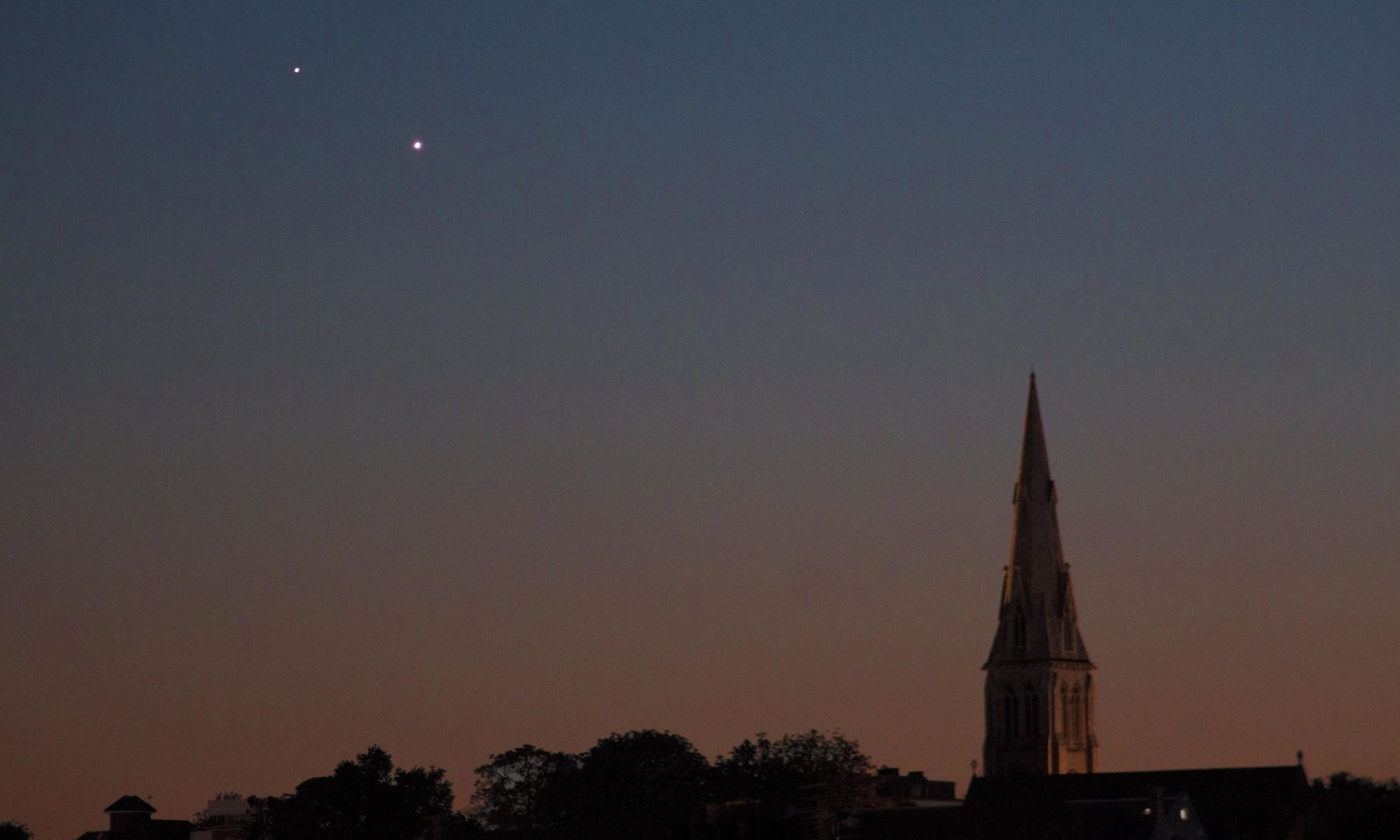The two brightest planets pass less than half a degree apart at dusk during a spectacular conjunction on the night of March 1st.
It has begun. Once every 12 to 18 months or so, I start fielding “what are those two bright objects in the sky?” questions. They’re none other than the third and fourth brightest natural objects in the sky (behind the Sun and the Moon), the planets Jupiter and Venus. If skies are clear, you can see them get ever closer together from one night to the next, as they meet up during a spectacular conjunction on the night of March 1st/2nd.
The celestial action is already afoot, as the slim waxing crescent Moon pays the closing pair a visit on the night of Wednesday February 22nd. The Moon will actually occult (pass in front of) Jupiter for the southern tip of South America on Wednesday evening: the rest of us will see a close pass.

The Moon occults Jupiter four times in 2023. the next two dates are March 22nd and April 19th, though Jove will also be close to the Sun around this time, as it reaches solar conjunction on April 11th. The final event occurs on May 17th and could be an interesting one for the southwestern United States and Mexico at dawn.

The Moon also occults Venus on March 24th, and again later this year on November 9th. These close passes also offer a rare chance to spot -3.9 magnitude Venus (and perhaps, even -2.1 magnitude Jupiter) in the daytime, using the nearby waxing crescent Moon as a guidepost.

This leads up to the big event on Wednesday March 1st, as Jupiter passes just 29’ (about one Full Moon diameter) from Venus at 5:00 Universal Time (UT) on March 2nd. The two will be close enough to easily fit in a low power field of view, though (mainly Venus) is really truckin’, moving an apparent distance of one full degree from just one evening before and after. Though the conjunction is one of the best naked eye planet versus planet conjunctions for 2023, it isn’t the closest overall; that award goes to last week’s rare Venus-Neptune conjunction, when the two were just 42” apart.

The March 1st conjunction is the closest for Venus and Jupiter since April 30th, 2022. The two planets won’t be closer until May 23rd, 2024. Venus and Jupiter are 31 degrees east of the Sun at closest approach on next week, placed well in the dusk.

Conjunction: Looking back from Jove
Now, for the wow! factor of what you’re seeing: Venus is an apparent disk 12” across and 86% illuminated during the pass, while Jupiter is 34” across. Of course, gas giant Jupiter is much larger than Venus… but it’s also over four times farther away, at 5.77 Astronomical Units (AU) or over 537 million miles (1.18 billion kilometers) distant. Looking back from Jupiter, you’d see Earth and Venus in a close 25’ embrace, with the +4.6 magnitude Moon thrown in.

And speaking of the Moon, this lunation sets us up for the start of the Roman Catholic season of Lent this week, with the Paschal Full Moon falling on the lunation after next on April 6th, and Easter 2023 falling on the following Sunday on April 9th. The Muslim calendar, which strictly follows the lunar cycle, also sees the start of Ramadan 2023, beginning with the next lunation and the expected first sighting of the slim crescent Moon on March 22nd.

When it comes the sky-watching, knowledge of planetary conjunctions can also have geopolitical significance. For instance, in 2013 Indian Army guards along the nation’s border with China suspected that two bright lights seen night after night were actually Chinese spy drones with nefarious intent. The true culprits were—you guessed it—Venus and Jupiter during a particularly fine conjunction. Hey, astronomy can save lives… or at least, avert a super-power confrontation. A good thing to keep in mind, as NORAD is currently chasing spurious balloons across North American skies.
Watch the conjunction of Venus and Jupiter live, courtesy of astronomer Gianluca Masi and the Virtual Telescope project: the show starts on Wednesday, February 22nd at 19:00 UT/2:00 PM EST.

